#WYNN models
Explore tagged Tumblr posts
Text

Been playing oblivion
#I just run around tasering ppl with my hands and swapping out pretty dresses#might draw her in more dresses who knows#she’s named Wynn in the game but modeled after me snsnsnsnsn#idk I just like the name#w is a pretty letter#the shading sucks just ignore it lol#tes#oblivion#tes iv: oblivion#astro.scribbles
20 notes
·
View notes
Text

Ok so, ive seen some people on here draw their Wynncraft characters/ocs and that looked like fun. So heres mine!
Balaís is an acolyte Shaman (which is a really fun archetype, i can redommend it). he sits currently at level 75, as my highest level playthrough
Anyway, time to talk design. I hate drawing armor so you only get pauldrons, the armor is changing a lot anyway during my game so... the other equipment should be acounted for. The portal encounter is based on me standing in the portal for a minute and getting disappointed. while the golem parts are from me not following the wynn-OSHA regulations for production safety.
Also this is propaganda to get you to play Wynncraft
#notably @berryyjello and @wassup-its-e inspired me to do this and are a huge catalyst for me to want to draw more wynn content in the future#Please check out their art its so so gorgeouss!!!#Also if anyone knows where if theres a list with Rythew's weapon models from their Fables and Legends resource pack hit me up#wynncraft#wynncraft oc#oc art#art#semigoodart#original art#character art#my oc art#I really hope the portal gets more content#i know it gets a world event next update#and i dont know how it is at higher levels#but the complete removal of the timelost sanctuary quest lost a lot of lore#i hope the removal of the quest requirements for dungeons doesnt remove the quest completly#because that makes the dungeons just random places#(dungeons should have more build up anyway like Infested Pit not less)#(like Garoth is just a guy chilling in a bridge now)#oc: balaís
9 notes
·
View notes
Text
David Gaider on Flemeth, under a cut for length:
"I have a type. I admit it. There are certain wells I can return to repeatedly and always find something new to explore. One of them is older female characters. Mike used to rib me about it. Consider Wynne. Meredith. Genevieve. And, of course, the biggie: Flemeth. Why are they a type? I... don't know, honestly. I guess I have a feeling that older men fade, they strive to regain their youth or establish a legacy and we've seen that story a thousand times, but older women? They become free to become something new. I guess I see so many possibilities in that. I had a conception of who Flemeth was, and why, right from the very start. Her creation went hand in hand with Morrigan, as a being whose thirst for retribution hundreds of years ago attracted an entity (slight confession: I didn't know Mythal specifically, at the time, "an elven god" was enough). I also knew where Morrigan was right and very wrong about her. Misconceptions of the truth are built into DA's foundation, and they were fundamental to this mother-daughter relationship I was building. Like many seeds I'd put in the world, however, I had no idea whether I'd ever get to explore it. Knowing that she was a character of possible future importance, if not a major player in DAO, I wasn't much surprised when she was one of the first cuts the art team made in terms of getting a unique appearance. Thus the "batty old woman" players met in DAO. Not as hard a cut as the Qunari, though."
"Going into DA2, I wanted both Morrigan and Flemeth, but we could only have one. So I picked Flemeth. This was the game where she really got to come into her own. I remember the art team coming and asking if it was OK if she got a new model, as it'd be a retcon of sorts. I didn't care. I wanted it. I honestly don't remember whether Kate Mulgrew was cast before or after Claudia. After, I think? All I recall is that Cab came into my office one day and asked if Kate might be a good fit. Asked me, the dyed-in-the-wool Trekkie who had stuck with Voyager even through the admittedly lean years? The squeal I made was un-manly. Cab took that as a "yes". 😅 I didn't get to talk to Kate until DA2, however. Schedules being what they were, we had a tight window to record Flemeth... so I had to write all her scenes before almost anything else in DA2 was written, before I even had a team! Ack! It was OK, though, for the most part. I knew where I wanted to take her, and a big part of it was going to explain her transition - to set her up for the future. So I whipped up a script in, like, two days and off we went. Kate was a marvel in the booth. She adored Flemeth and you could really tell. I didn't get to meet Kate in person, however, until DAI. This came pretty late in its development, compared to when we recorded her for DA2, and we flew down to Virginia (to accommodate her schedule - she was writing her memoir at the time, I think) for a single session. It was going to be *tight*."
"I was a mess. I was finally going to meet Captain Janeway... and yes yes, I know she's also more than that. But come ON. When we sat down, I figured I'd have to talk her through the character all over again. It'd been years since that one session at the start of DA2, right? And even more since DAO. But, no. Kate remembered Flemeth perfectly. I remember sitting there as she told me how much she loved the character, how rare it was to get one with so much texture and possibility. She called out my writing - my writing! - and waxed poetic about how she viewed Flemeth's arc. I... I was floored. 🫠 Then we began recording. One issue that quickly reared its head was how Caroline had to speed through the lines if we hoped to finish. Kate was a trooper, and most takes she'd get it in one (which is rare), but I was alarmed because we weren't giving Kate time to read the VO comments on each line. I brought it up, as there were some lines (so much sarcasm) that required nuance - Kate was getting them, oddly, but I was worried. "Oh, it's fine," Kate said. "I read the comments as we go." "How could you? We're going so fast!" "I'm a speed reader." Oh. OK, then. That certainly explained it. 😁 We got to the confrontation scene with Morrigan and she nailed it. Over and over. More than once, Caroline would make a call and, before I could even interject and say "no, Kate had it right, actually" Kate would explain exactly why she did it that way and why it worked for Flemeth. I was in love. She did the "I will see her avenged!" section all in one go. I got chills. Then we got to the final scene. You know the one. With Solas. It was this beautiful moment. She took it somewhere quiet and sad... and when she got to that last line, we all felt it: Flemeth was dead. Everyone was in tears. I suppose I could talk more about the process. How she started off aligned with Morrigan's original Delirium inspiration, but I didn't pull back her loopy way of talking as much (bet you wondered). I still don't know why it was so easy to slip into her voice, but I'm grateful I got the chance. ❤️"
[source thread]
295 notes
·
View notes
Text

Scale model and artist's renderings of The Mirage, c. 1987
The hotel was built by Golden Nugget Inc, headed by Steve Wynn, and this model of the resort was on display at downtown’s Golden Nugget Hotel & Casino.
Early names for the resort included Bombay Club, and Golden Nugget on the Strip. Groundbreaking was Aug. 1987. The final name was announced late in '88. The hotel opened 11/22/89.




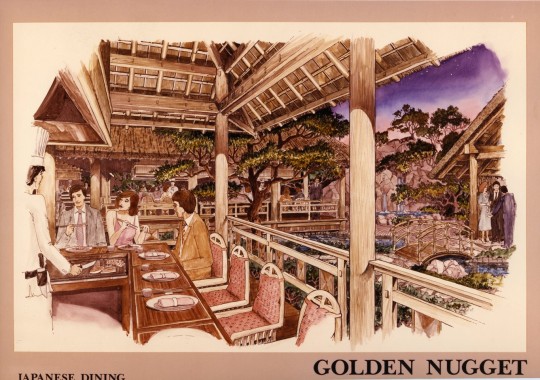
189 notes
·
View notes
Text
this is not a drill, this is a thread on the creation of Flemeth from David Gaider!! as kind of the self professed Flemeth stan blog around here, I had to reshare
(alt text and full text transcript of the images included)
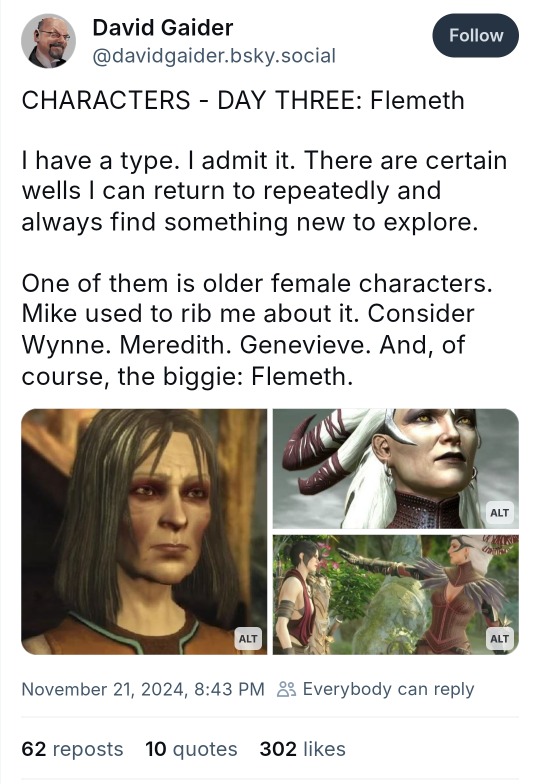
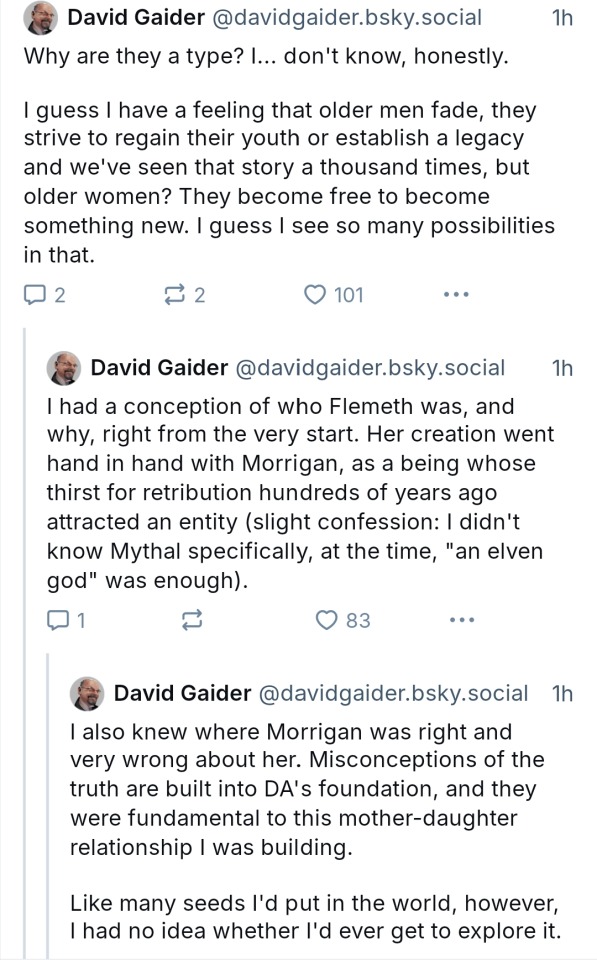

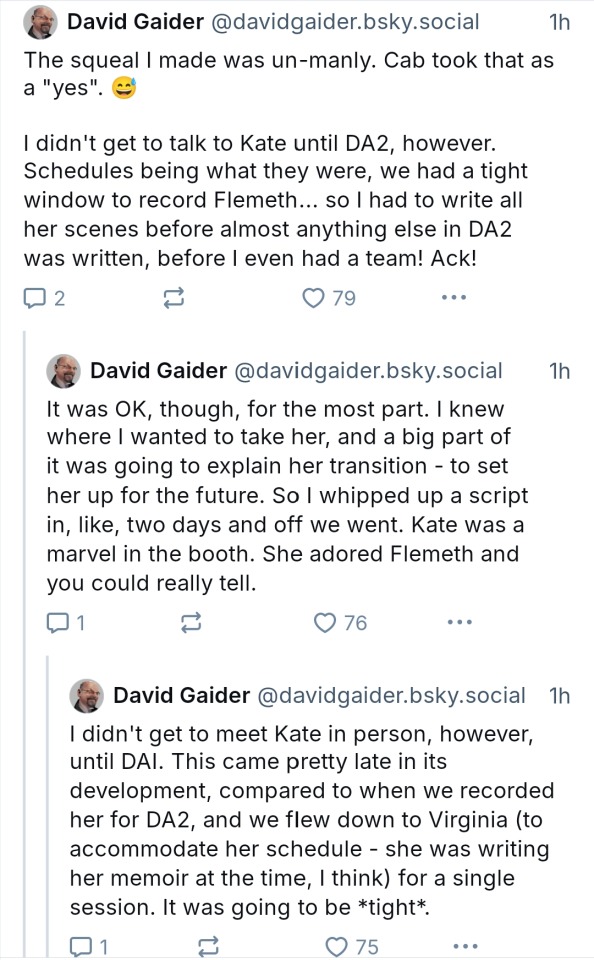
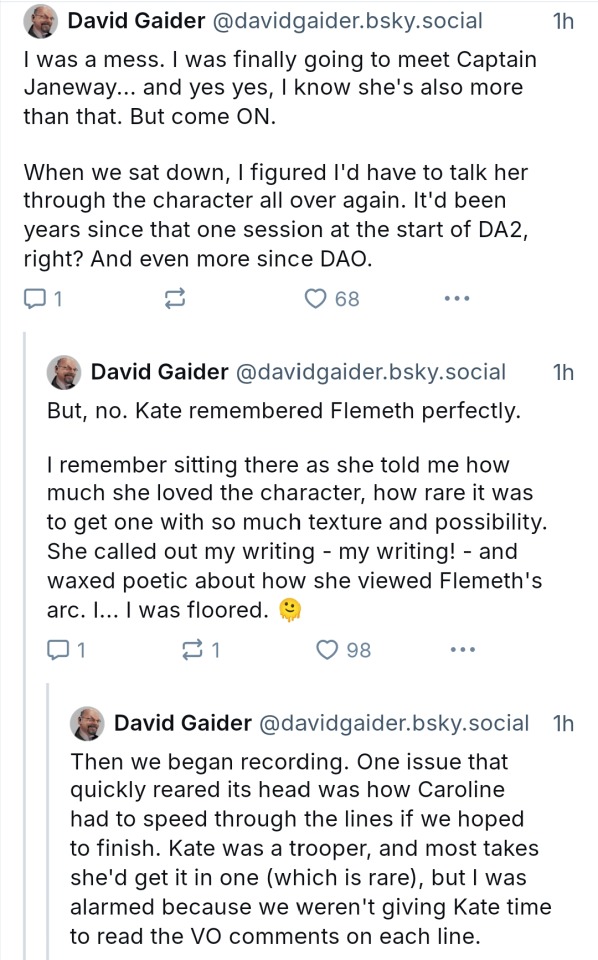
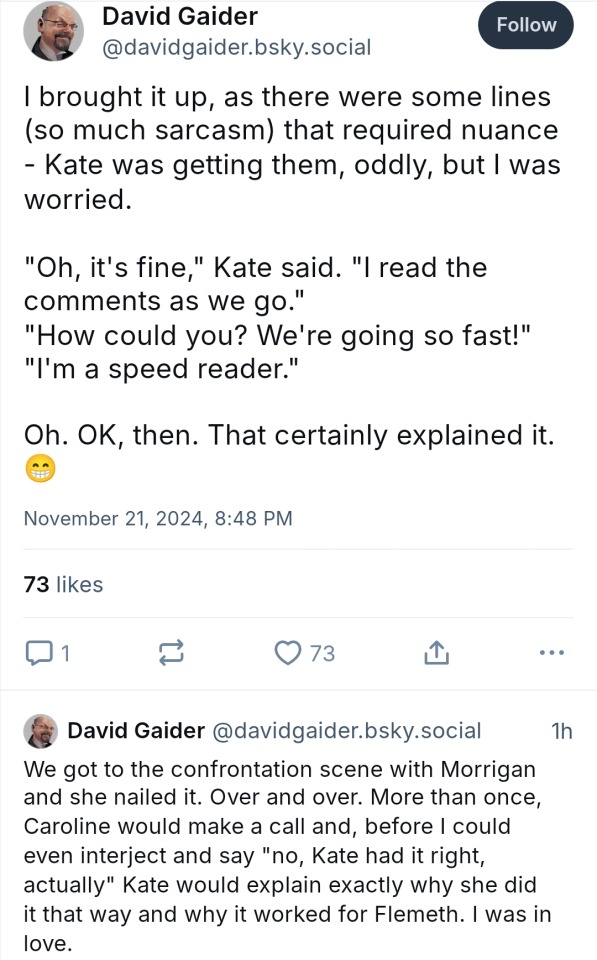
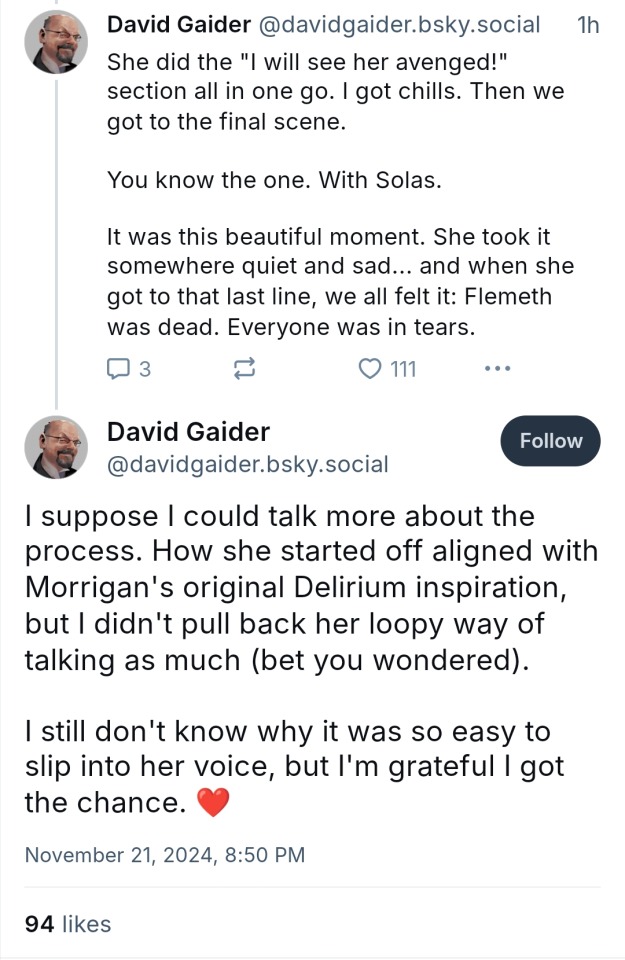
Link to the original post
Full text from the images below the cut:
CHARACTERS - DAY THREE: Flemeth
I have a type. I admit it. There are certain wells I can return to repeatedly and always find something new to explore.
One of them is older female characters. Mike used to rib me about it. Consider Wynne. Meredith. Genevieve. And, of course, the biggie: Flemeth.
Why are they a type? I... don't know, honestly.
I guess I have a feeling that older men fade, they strive to regain their youth or establish a legacy and we've seen that story a thousand times, but older women? They become free to become something new. I guess I see so many possibilities in that.
I had a conception of who Flemeth was, and why, right from the very start. Her creation went hand in hand with Morrigan, as a being whose thirst for retribution hundreds of years ago attracted an entity (slight confession: I didn't know Mythal specifically, at the time, "an elven god" was enough).
I also knew where Morrigan was right and very wrong about her. Misconceptions of the truth are built into DA's foundation, and they were fundamental to this mother-daughter relationship I was building.
Like many seeds I'd put in the world, however, I had no idea whether I'd ever get to explore it.
Knowing that she was a character of possible future importance, if not a major player in DAO, I wasn't much surprised when she was one of the first cuts the art team made in terms of getting a unique appearance. Thus the "batty old woman" players met in DAO. Not as hard a cut as the Qunari, though.
Going into DA2, I wanted both Morrigan and Flemeth, but we could only have one. So I picked Flemeth. This was the game where she really got to come into her own.
I remember the art team coming and asking if it was OK if she got a new model, as it'd be a retcon of sorts. I didn't care. I wanted it.
I honestly don't remember whether Kate Mulgrew was cast before or after Claudia. After, I think? All I recall is that Cab came into my office one day and asked if Kate might be a good fit
The squeal I made was un-manly. Cab took that as a "yes". 😅
I didn't get to talk to Kate until DA2, however. Schedules being what they were, we had a tight window to record Flemeth... so I had to write all her scenes before almost anything else in DA2 was written, before I even had a team! Ack!
It was OK, though, for the most part. I knew where I wanted to take her, and a big part of it was going to explain her transition - to set her up for the future. So I whipped up a script in, like, two days and off we went. Kate was a marvel in the booth. She adored Flemeth and you could really tell.
I didn't get to meet Kate in person, however, until DAI. This came pretty late in its development, compared to when we recorded her for DA2, and we flew down to Virginia (to accommodate her schedule - she was writing her memoir at the time, I think) for a single session. It was going to be *tight*.
I was a mess. I was finally going to meet Captain Janeway... and yes yes, I know she's also more than that. But come ON.
When we sat down, I figured I'd have to talk her through the character all over again. It'd been years since that one session at the start of DA2, right? And even more since DAO.
But, no. Kate remembered Flemeth perfectly.
I remember sitting there as she told me how much she loved the character, how rare it was to get one with so much texture and possibility. She called out my writing - my writing! - and waxed poetic about how she viewed Flemeth's arc. I... I was floored. 🫠
Then we began recording. One issue that quickly reared its head was how Caroline had to speed through the lines if we hoped to finish. Kate was a trooper, and most takes she'd get it in one (which is rare), but I was alarmed because we weren't giving Kate time to read the VO comments on each line.
I brought it up, as there were some lines (so much sarcasm) that required nuance - Kate was getting them, oddly, but I was worried.
"Oh, it's fine," Kate said. "I read the comments as we go."
"How could you? We're going so fast!"
"I'm a speed reader."
Oh. OK, then. That certainly explained it. 😁
We got to the confrontation scene with Morrigan and she nailed it. Over and over. More than once, Caroline would make a call and, before I could even interject and say "no, Kate had it right, actually" Kate would explain exactly why she did it that way and why it worked for Flemeth. I was in love.
She did the "I will see her avenged!" section all in one go. I got chills. Then we got to the final scene.
You know the one. With Solas.
It was this beautiful moment. She took it somewhere quiet and sad... and when she got to that last line, we all felt it: Flemeth was dead. Everyone was in tears.
I suppose I could talk more about the process. How she started off aligned with Morrigan's original Delirium inspiration, but I didn't pull back her loopy way of talking as much (bet you wondered).
I still don't know why it was so easy to slip into her voice, but I'm grateful I got the chance. ❤️
#flemeth#flemeth dragon age#dragon age#dragon age origins#dragon age 2#dragon age inqusition#dao#da2#dai#morrigan dragon age#david gaider
41 notes
·
View notes
Text
did you guys know about courtly love??? because I didn't
My introduction to courtly love was reading a Diana Wynne Jones novella that made no sense unless you know what courtly love is. After crawling confusedly through ancient Livejournal reviews to piece together what the story had been about, I took away that it was a weird medieval knight thing where you talk a lot of guff to a (married) woman without ever expecting it to turn into more than what it is.
The first chapter of CS Lewis's The Allegory of Love explains the concept much more thoroughly. His account is pleasantly bonkers. I now relay it to you. (Note: not only am I skeptical of parts of his account, I read it while sleep deprived, so salt liberally.)
First, a sketch of the relationship:
The lover is always abject. Obedience to his lady’s lightest wish, however whimsical, and silent acquiescence in her rebukes, however unjust, are the only virtues he dares to claim. There is a service of love closely modelled on the service which a feudal vassal owes to his lord. The lover is the lady’s ‘man’. He addresses her as midons, which etymologically represents not ‘my lady’ but ‘my lord’. The whole attitude has been rightly described as ‘a feudalisation of love’. This solemn amatory ritual is felt to be part and parcel of the courtly life.
This seems to have been both literary trope and a real-life interaction pattern (of which the former came first). A specific example in Arthuriana:
It is only later that [Lancelot] learns the cause of all this cruelty. The Queen has heard of his momentary hesitation in stepping on to the tumbril[, a humiliating cart he rode into the city where she was held captive, to rescue her], and this lukewarmness in the service of love has been held by her sufficient to annihilate all the merit of his subsequent labours and humiliations. Even when he is forgiven, his trials are not yet at an end. The tournament at the close of the poem gives Guinevere another opportunity of exercising her power. When he has already entered the lists, in disguise, and all, as usual, is going down before him, she sends him a message ordering him to do his poorest. Lancelot obediently lets himself be unhorsed by the next knight that comes against him, and then takes to his heels, feigning terror of every combatant that passes near him. The herald mocks him for a coward and the whole field takes up the laugh against him: the Queen looks on delighted. Next morning the same command is repeated, and he answers, ‘My thanks to her, if she will so’. This time, however, the restriction is withdrawn before the fighting actually begins.
So, huh. How did this cultural script come to be?
Courtly love as a literary trope began in 11th century Provence. Here's Lewis's sketch of that time and place:
We must picture a castle which is a little island of comparative leisure and luxury, and therefore at least of possible refinement, in a barbarous country-side. There are many men in it, and very few women—the lady, and her damsels. Around these throng the whole male meiny [i.e. attendants], the inferior nobles, the landless knights, the squires, and the pages—haughty creatures enough in relation to the peasantry beyond the walls, but feudally inferior to the lady as to her lord—her ‘men’ as feudal language had it. Whatever ‘courtesy’ is in the place flows from her: all female charm from her and her damsels. There is no question of marriage for most of the court. All these circumstances together come very near to being a ‘cause’; but they do not explain why very similar conditions elsewhere had to wait for Provençal example before they produced like results. Some part of the mystery remains inviolate.
So that's the material background – a lopsided gender balance. But more fascinating is the cultural background where the passion and devotion of romantic love – a passion/devotion Lewis claims simply did not exist as a mode for men to treat women in Europe before courtly love was invented – could not be channeled into marriage because such a stance is incompatible with the social role of a husband:
The same woman who was the lady and ‘the dearest dread’ of her vassals was often little better than a piece of property to her husband. He was master in his own house. So far from being a natural channel for the new kind of love, marriage was rather the drab background against which that love stood out in all the contrast of its new tenderness and delicacy. The situation is indeed a very simple one, and not peculiar to the Middle Ages. Any idealization of sexual love, in a society where marriage is purely utilitarian, must begin by being an idealization of adultery.
In fact, courtly love's rightful predecessor is not heterosexual love but the love of a vassal for his lord. (I am quite skeptical of this as a claim about reality, but less skeptical of it as a claim about literature.) Reiterating a sentence from the first quote in this post:
The whole attitude [of a knight in courtly love with his lady] has been rightly described as ‘a feudalisation of love’.
CS Lewis on that feudal relationship:
We shall never understand [the affection between vassal and lord], if we think of it in the light of our own moderated and impersonal loyalties. We must not think of officers drinking the king’s health: we must think rather of a small boy’s feeling for some hero in the sixth form. There is no harm in the analogy, for the good vassal is to the good citizen very much as a boy is to a man. ... He loves and reverences only what he can touch and see; but he loves it with an intensity which our tradition is loath to allow except to sexual love.
So it's that relationship that courtly love remixes into heterosexual romance. Courtly love ennobles the lover – there's a religious parallel here for sure. And it is necessarily adulterous because marriage is not a matter of personal passion, because distance is conducive to recreational idealization, because the lack of potential sexual consummation is pleasantly purity-coded in a Christian society, and because a wife, being a knight's inferior, cannot ennoble him. So, finally, Lewis says bluntly:
The love which is to be the source of all that is beautiful in life and manners must be the reward freely given by the lady, and only our superiors can reward. But a wife is not a superior.
Coming back briefly to Diana Wynne Jones's The True State of Affairs: I understand much better now the behavior of the protagonist's love interest. He's a bored would-be king in captivity who decides to make the other visible prisoner his midons. He expects her to understand the convention he's following. Why shouldn't he take her on as a concept like this? She, also bored and deprived, benefits from his gifts and minor heroics. He wants an ennobling influence. And besides, isn't idealizing a beautiful woman you never intend to make a move on fun?
201 notes
·
View notes
Text
Summaries under the cut
The Doll People by Ann M. Martin and Laura Godwin
Annabelle Doll is 8 years old--and has been for over 100 years. Nothing much has changed in the dollhouse during that time, except for the fact that 45 years ago, Annabelle's Auntie Sarah disappeared from the dollhouse without a trace. After all this time, restless Annabelle is becoming more and more curious about her aunt's fate. And when she discovers Auntie Sarah's old diary, she becomes positively driven. Her cautious family tries to discourage her, but Annabelle won't be stopped, even though she risks Permanent Doll State, in which she could turn into a regular, nonliving doll. And when the "Real Pink Plastic" Funcraft family moves in next door, the Doll family's world is turned upside down--in more ways than one!
Ivy & Bean by Annie Barrows
The moment they saw each other, Bean and Ivy knew they wouldn't be friends. But when Bean plays a joke on her sister, Nancy, and has to hide quickly, Ivy comes to the rescue, proving that sometimes the best of friends are people never meant to like each other. Vibrant characters and lots of humor make this a charming and addictive introduction to Ivy and Bean.
Hans Brinker, or the Silver Skates by Mary Mapes Dodge
For youngsters of the Dutch village, the time is especially exciting. But Hans and Gretel Brinker, with their hand-carved wooden blades, can hardly expect to compete against their well-trained young friends who own costly steel skates. Raff Brinker, their father, is seriously ill, and the desperately poor family is struggling to survive. To win the race, the siblings will need a miracle — and a helping hand.
The Sea of Trolls by Nancy Farmer
The year is A.D. 793; Jack and his sister have been kidnapped by Vikings and taken to the court of Ivar the Boneless and his terrifying half-troll wife; but things get even worse when Jack finds himself on a dangerous quest to find the magical Mimir's Well in a far-off land, with his sister's life forfeit if he fails.
A Dog's Life by Ann M. Martin
Squirrel and her brother Bone begin their lives in a toolshed behind someone's summer house. Their mother nurtures them and teaches them the many skills they will need to survive as stray dogs. But when their mother is taken from them suddenly and too soon, the puppies are forced to make their own way in the world, facing humans both gentle and brutal, busy highways, other animals, and the changing seasons. When Bone and Squirrel become separated, Squirrel must fend for herself, and in the process makes two friends who in very different ways define her fate.
The Willoughbys by Lois Lowry
Abandoned by their ill-humored parents to the care of an odious nanny, Tim, the twins, Barnaby A and Barnaby B, and their sister, Jane, attempt to fulfill their roles as good oldfashioned children. Following the models set in lauded tales from A Christmas Carol to Mary Poppins, the four Willoughbys hope to attain their proscribed happy ending too, or at least a satisfyingly maudlin one. However, it is an unquestionably ruthless act that sets in motion the transformations that lead to their salvation and to happy endings for not only the four children, but their nanny, an abandoned baby, a candy magnate, and his long-lost son too.
H.I.V.E. by Mark Walden
Otto Malpense may only be thirteen years old, but so far he has managed to run the orphanage where he lives, and he has come up with a plan clever enough to trick the most powerful man in the country. He is the perfect candidate to become the world's next supervillain.
That is why he ends up at H.I.V.E., handpicked to become a member of the incoming class. The students have been kidnapped and brought to a secluded island inside a seemingly active volcano, where the school has resided for decades. All the kids are elite; they are the most athletic, the most technically advanced, and the smartest in the country. Inside the cavernous marble rooms, floodlit hangars, and steel doors, the students are enrolled in Villainy Studies and Stealth and Evasion 101. But what Otto soon comes to realize is that this is a six-year program, and leaving is not an option.
With the help of his new friends: an athletic martial-arts expert; a world-famous, beautiful diamond thief; and a spunky computer genius -- the only other people who seem to want to leave -- can Otto achieve what has never been done before and break out of H.I.V.E.?
Journey to the River Sea by Eva Ibbotson
Sent in 1910 to live with distant relatives who own a rubber plantation along the Amazon River, English orphan Maia is excited. She believes she is in for brightly colored macaws, enormous butterflies, and "curtains of sweetly scented orchids trailing from the trees." Her British classmates warn her of man-eating alligators and wild, murderous Indians. Unfortunately, no one cautions Maia about her nasty, xenophobic cousins, who douse the house in bug spray and forbid her from venturing beyond their coiffed compound. Maia, however, is resourceful enough to find herself smack in the middle of more excitement than she ever imagined, from a mysterious "Indian" with an inheritance, to an itinerant actor dreading his impending adolescence, to a remarkable journey down the Amazon in search of the legendary giant sloth.
Babe the Sheep-Pig by Christ Grant-Bear
When Babe arrives at Hogget Farm, Mrs. Hogget’s thoughts turn to sizzling bacon and juicy pork chops—until he reveals a surprising talent for sheepherding, that is. Before long, Babe is handling Farmer Hogget’s flock better than any sheepdog ever could. Babe is so good, in fact, that the farmer enters him into the Grand Challenge Sheepdog Trials. Will it take a miracle for Babe to win?
The Chronicles of Chrestomanci by Diana Wynne Jones
Cat doesn't mind living in the shadow of his sister, Gwendolen, the most promising young witch ever seen on Coven Street. But trouble starts brewing the moment the two orphans are summoned to live in Chrestomanci Castle. Frustrated that the witches of the castle refuse to acknowledge her talents, Gwendolen conjures up a scheme that could throw whole worlds out of whack.
#best childhood book#poll#the doll people#ivy and bean#hans brinker or the silver skates#the sea of trolls#a dog's life#the willoughbys#h.i.v.e.#journey to the river sea#babe the sheep pig#the chronicles of chrestomanci
28 notes
·
View notes
Text
Rhûnic
Leith McPherson, who's the dialect coach for Rings of Power, talked in an interview a while ago about Rhûnic language the show uses:
For Leith, the challenge was a welcome one. “This season, we journey to the land of Rhûn,” she says. Rhûn is largely a mystery in Tolkien’s published works, a vast expanse of Middle-earth left intentionally vague by the author. But for the series, Tolkien scholars working with the show have unearthed some of Tolkien’s unpublished notes and used them to build out the beginnings of a language for Rhûn. “Never heard before, never worked with before,” Leith says, her voice practically glowing with enthusiasm. “That was just a gift this season.”
Bear McCreary has since talked about it on his blog, and included the 'Rhûnic' lyrics he used and their English translation:
Rhûnic: Fú nimžil, nimžil-feg, aibesjar balan taugun. Dunšig Lún, ligrám lihiš bódi aišäd bil. Dyúl hez ní, feč Šigór. þabul nädo naþa-feg je. dyúl gileg anže þurfeg jai. Dyúl hez ní, feč Šigór. gorul arkädfeg go, þur če žilid-feg bil. I Raib-aišäd. English: Under moonlight, moonlight thine, Our sister carried far. Dark Magic, White wings beat in sacred shrine. Command her, thou Istar. Grant flesh to thy servant. Bring her forth with your might. Command her, thou Istar. Rise from thy throne, In thy power and splendor. The border shrine.
And in this article on Fellowship of Fans this month, someone's speculated that the language in question is 'Magol', a language Tolkien played around with in the 1930s:
I am not a specialist in Hungarian, nor indeed in any Uralic language. Nevertheless, after comparing the phonology of Hungarian with the phonology of Rhûnic (as used in The Rings of Power), I am virtually certain that Rhûnic may be identified as an extension of Mágol, Tolkien’s Hungarian-based language. However, I suspected this to be so even before I heard a word of Rhûnic, so it may be a case of confirmation bias. If not directly based on Mágol, Rhûnic may instead be an extrapolated mother, aunt, sister, or daughter language, created by applying regular sound changes. Of course, given that the material on Mágol is as yet unpublished, it is difficult to say how much of Rhûnic derives from Tolkien’s work, and how much had to be invented by linguists working for the show.
Tolkien's notes on Mágol remain unpublished, but Tolkien linguist Patrick Wynne has seen them and has previously talked about it a little:
"Tolkien's Hungarian-style language is actually called _Mágol_. In the earlier of the two texts on this language it is called _Mágo_ and more closely resembles Adunaic than Hungarian; this same text also says that 'Old Mágo' was the language of the children of Húrin. "In the later text, the language is called _Mágol_ and seems clearly modeled after Hungarian in phonology and grammatical structure, while retaining a strong Elvish influence as well -- it reminds me of something that might have been spoken by a lost tribe of Avari who had taken up residence outside Budapest for a few millennia.
A lost tribe of elves living in the east you say? Curious. Curious...
(I didn't even intend this to be yet another post about TROP Celeborn being part of the Rhûn storyline! I swear I started writing it before seeing that Patrick Wynne post!)
(also it is so very Rings of Power to do something very cool with depth and care about one of Tolkien's languages as a throwaway part of worldbuilding and then not mention it at all in favour of concentrating the publicity info on monster special effects or yet more detail about how they filmed the Big Epic Battle, despite the Big Epic Battle stuff being so much less interesting than this.)
#rings of power#rhun#lost iathrim#Celeborn come back and join the long list of people wanting to yeet Kemen into the ocean for threatening trees
14 notes
·
View notes
Text
In at least one version he takes some really cheap and really bigoted shots at the Irish for being catholic, so be aware if you go looking for this speech.
To be clear, I hate him, but God what a talent is wasted there.
Hitchens was full of shit in some ways but I would love to have his gift for oratory. One time he was asked, by Dennis Prager, in fact, if he would be more or less afraid of a group of strange men coming towards him, if he knew they were coming from a prayer meeting, and he said, and this is absolute horseshit, made up out of whole cloth:
"I was able to answer it as if it was not hypothetical. Just to stay within the letter 'B', I have had that experience, in Belfast, Beirut, Bombay, Belgrade, Bethlehem and Baghdad. In each case I can say absolutely, and can give my reasons, why I would feel immediately threatened if I thought that the group of men approaching me in the dusk had come from religious observance."
Yeah, like, maybe two or three of those cities, but that's a really specific experience to have had in a list of cities starting with the letter B and corresponding to a list of major religions and sects, Catholicism, Islam, Hinduism, Eastern Orthodoxy, Judaism, and Islam again (because Hitchens really, really has it in for Islam).
But God, what a speech to deliver with absolute fucking patter. He probably rehearsed it a hundred times, but all the audience sees is the effortless flow of "Belfast, Beirut, Bombay [...]" I kinda hate him. But God what a talent.
#drunkposting#I suppose there are much better role models if I want to learn to be a pretentious ass... Natalie Wynn...#But sometimes the edgy teenage atheist in me and the BA in English literature come together in their desire to be a stuffy British man#using archaic words to eviscerate world religions for 10 000 pounds sterling a show
3 notes
·
View notes
Note
could you elaborate your thoughts more on "but should we believe Wynne-Jones' Calcifer or the youkai/ayakashi of animanga are meant to be that kind of demon?" and "It's the same cultural disconnect that led so many Christian parents in the 90s to condemn Pokemon as satanic". Specially about Calcifer? Please?
I wish that when translating asian media, particularly anime, they would keep their non-translated nomenclature, it always translates to "demon" or whatever alternative we have.
Well part of the issue is that our word "demon" comes from the Greek word δαίμων or daimōn, which is the word used in the New Testament, but it is not a word invented by the New Testament writers. Here is an excerpt from the Oxford Reference about it:
Etymologically daimōn means ‘divider’ or ‘allotter’; from Homer onwards it is used mainly in the sense of performer of more or less unexpected, and intrusive, events in human life. In early authors, gods, even Olympians, could be referred to as daimŏnĕs. Rather than referring to personal anthropomorphic aspects, however, daimōn appears to correspond to supernatural power in its unpredictable, anonymous, and often frightful manifestations. So, the adjective daimonios means ‘strange’, ‘incomprehensible’, ‘uncanny’. Hence daimōn soon acquired connotations of Fate. Hesiod introduced a new meaning: the deceased of the golden age were to him ‘wealth‐giving daimones’ functioning as guardians or protectors. This resulted in the meaning ‘personal protecting spirits’, who accompany each human's life and bring either luck or harm. A lucky, fortunate person was eudaimōn (‘with a good daimon’: already in Hesiod), an unlucky one was kakodaimōn (‘with a bad daimon’: from the 5th cent. bc). Centuries later, Christian theologians, concentrating on their negative aspects, saw in daimones the true nature of the pagan gods: they were the embodiment and source of evil and sin.
With this in mind, it makes sense that for translators, the most sophisticated translation for any kind of supernatural weird little creature would be "demon" or "daemon." Especially in a modernist, materialist society that views Judeo-Christian demons as merely one mythology out of many.
Calcifer is a very interesting case, because while he is called a demon in the Japanese Studio Ghibli adaptation, he is also called a demon in the original book by Welsh author Diana Wynne Jones. What many people don't realize is that Mrs. Jones was highly educated, having studied at Oxford under the likes of J.R.R. Tolkien and C.S. Lewis. Her husband was also a scholar of Chaucer. Unfortunately, I think because she was writing children's fantasy in the 70s and 80s, people don't think her work warrants much deeper analysis.
As with all her stories, I think she brought a special kind of cleverness to the table when writing Calcifer that is first exemplified by his name.
"Calcifer" is a common noun, referring to sea creatures like anemones which construct their own shells from Calcium Carbonate, much like how Calcifer constructs the moving castle.
"Calcifer" resembles the Latin model of "Lucifer" which means "bringing light" or "light bringer," but rather than "light" she's substituted the Latin root for "limestone" (calcis), which is also made of Calcium Carbonate.
You know what's neat about Calcium Carbonate? It doesn't burn.
Following this thread through to Calcifer's backstory:
Calcifer was a falling star that Howl intercepted, which slightly resembles Satan's origin story as a fallen angel of light. However, Diana Wynne Jones knew perfectly well that Christian demons are not really falling stars, so we can know she did not intend to write Calcifer as a Judeo-Christian demon. More likely, I think she was paying homage to classics such as Paradise Lost.
Calcifer strikes a bargain with Howl for his heart, which I consider an homage to Faust by Goethe, in which the titular character can be said to have devoured beautiful young women.
As a character, Calcifer is very morally grey and often seems in a league above the other characters as far as stakes and decision-making. This is very characteristic of the mythical creatures of Celtic legend, which are still a very present background element of Welsh culture today, much like the trolls and elves of Scandinavian culture. Many of these mythical creatures are referred to as demons, even though they do not align with the Judeo-Christian definition of a demon. Yes, they can be evil or tricky, but they can also be helpful, lucky, or funny. Mostly, they are volatile. Faeries, boggarts, goblins, elves, sea monsters, and more have all been called demons in Welsh folklore.
This could be due to the early interaction between the Welsh and the Romans (compared to, say, the Irish who kept up their Druidism for much longer), and consequently Christians. I know from Scandinavian folklore that the meshing of Pagan culture with Christian newcomers usually becomes very weird very quickly, with the resulting mythology resembling neither party.
Tl;dr Calcifer is the product of a Welsh upbringing and a classical education, and is explicitly not a demon in the Judeo-Christian sense.
As for Pokemon in the U.S., it's mainly a translation issue. Word got around that lots of Pokemon are based on youkai, which gets translated to "demon" in English, even though they are not Judeo-Christian demons and are much closer to the above cited faeries and goblins. Voila, Satanic Panic 2.0.
#thank you for this opportunity to nerd out today#Calcifer#DWJ#Studio Ghibli#x#Christianity#mythology#analysis#if you want to know what the actual demons of foreign cultures were; they were the primary deities they worshiped#and whichever spirits they invoked to practice magic or seeing#for this reason I would not watch Noragami for a long time.#but when I realized that modern Japan doesn't actually *believe* the Shintoism they observe#I knew it would be no different from reading The Odyssey or Gilgamesh#morally speaking
29 notes
·
View notes
Text

Construction of Fremont Street Experience, c. November 1994
Photo by Pam G.
Facing a stagnant economy and fearing that mega-resort projects on the Strip would further drain visitors to downtown casinos, Las Vegas City Council and downtown casino execs collaborated to create an attraction downtown which would become Fremont Street Experience.
Timeline of Fremont Street Experience
'91: Feb., Mirage Resorts chairman Steve Wynn suggests Venice-style canal attraction for Fremont St. Jul., City council forms committee to study downtown revitalization.
'92: Jan., Downtown Progress Association hears redevelopment proposals from three firms, rejects all. Apr., City begins purchasing property for future development use. Jun., Architect Jon Jerde presents plan for Fremont Street Experience.
'93: May, LVCVA approves $8M funding for FSE. Aug., City Council approves tax increase for financing the construction. Nov., City begins procedures to condemn property of owners who refuse to vacate on 400 block of Fremont St.
'94: Mar., Demolition of 400 block Fremont St. Sep. 7, Fremont St closed to traffic, and construction begins.
'95: Jul., Construction completed. Inaugurated Dec. 14.
2004: The canopy's 2 million incandescent bulbs replaced with 12.5 million LED lamps. The new light show dubbed Viva Vision debuts Jun. 14.
2014: Slotzilla zip line opened Apr. 27 (lower zipline) and Aug. 31 (upper zoomline).
2019: The Viva Vision display is rebuilt with 49 million LED lamps, competed Dec. 31. The new canopy can operate in daylight hours.

Demolition of Fremont & 4th (block 35), 1994. City of Las Vegas acquired the businesses on this block, partly through eminent domain, and demolished everything to make way for the Fremont Street Experience parking garage. Last building standing is Cornet 5-10-15 (401 Fremont). Photo taken from the garage of Fitzgerald’s Hotel & Casino by Roadsidepictures.

Section of scale model of Fremont Street Experience. Photographed Dec. 15, 1994, by Greg Cava. A 22-foot long scale model of Fremont Street Experience was built at the office of Atlandia Design, which supervised the creation of the attraction. Greg Cava Photograph Collection (PH-00399). UNLV Special Collections and Archives.

The “Vegas Vic” sign re-installed at Pioneer Club, December 23, 1994 - Photo by Las Vegas News Bureau. The sign was removed days earlier while the platform was extended from the building and the character’s hat was shortened, to accommodate the construction of the Fremont Street Experience canopy. The “Vegas Vickie” sign at Glitter Gulch casino was also lowered to fit under the canopy. Before the work was done on the two signs, a marriage ceremony was held on Fremont St for Vic and Vickie. Vic’s best man was Vaughn Cannon of YESCO. Guest of honor was Edna Sherrill who had played a “Vegas Vickie” character as a hostess at Pioneer Club in the 60s.
Sources include: Creative thinking needed downtown. Review-Journal, 2/25/91; H. Stutz. Wynn proposes Venice-style downtown project. Review Journal, 5/21/91; J. Gallant. Council, casinos plan revamp panel. Review-Journal, 7/18/91; C. Scarbrough. City, casino execs discuss three themes. Review-Journal, 1/30/92; C. Scarbrough. Megaresort projects threat to downtown. Review-Journal, 1/31/92; C. Scott. “Tourists to pick up most of project tab.” Las Vegas Sun, 4/17/94. S. McKinnon. “Downtown celebrates neon nuptial.” Review Journal, 12/17/94. Chris Jones. A vision of things to come. Review-Journal, 6/9/04.
28 notes
·
View notes
Photo

24 notes
·
View notes
Text
This day in history

#20yrsago HOWTO make a legal P2P system https://web.archive.org/web/20041009210429/https://www.eff.org/IP/P2P/p2p_copyright_wp.php
#15yrsago Google Book Search and privacy for students https://web.archive.org/web/20091002014504/http://freeculture.org/blog/2009/09/24/gbs-and-students-eff-privacy/
#10yrsago Fed whistleblower secretly recorded 46 hours of regulatory capture inside Goldman Sachs https://www.thisamericanlife.org/536/the-secret-recordings-of-carmen-segarra
#5yrsago Annalee Newitz’s “Future of Another Timeline”: like Handmaid’s Tale meets Hitchhiker’s Guide https://memex.craphound.com/2019/09/27/annalee-newitzs-future-of-another-timeline-like-handmaids-tale-meets-hitchhikers-guide/
#5yrsago Do Not Erase: Jessica Wynne’s beautiful photos of mathematicians’ chalkboards https://www.nytimes.com/2019/09/23/science/mathematicians-blackboard-photographs-jessica-wynne.html
#5yrsago Across America, the average worker can’t afford the median home https://www.marketwatch.com/story/there-are-precious-few-places-in-america-where-the-average-worker-can-afford-a-median-priced-home-2019-09-26
#5yrsago Amazon wants to draft model facial recognition legislation https://www.vox.com/recode/2019/9/25/20884427/jeff-bezos-amazon-facial-recognition-draft-legislation-regulation-rekognition
#5yrsago Doordash’s breach is different https://techcrunch.com/2019/09/26/doordash-data-breach/
#5yrsago Report from Defcon’s Voting Village reveals ongoing dismal state of US electronic voting machines https://media.defcon.org/DEF CON 27/voting-village-report-defcon27.pdf
#1yrago Intuit: "Our fraud fights racism" https://pluralistic.net/2023/09/27/predatory-inclusion/#equal-opportunity-scammers

Tor Books as just published two new, free LITTLE BROTHER stories: VIGILANT, about creepy surveillance in distance education; and SPILL, about oil pipelines and indigenous landback.

12 notes
·
View notes
Note
E, J, R for the ask meme!
E: What character do you identify with most? Is there a certain fic of yours that captures these qualities particularly well?
Armand from Interview with the Vampire. In our society, we have this idea that being a "people pleaser" is kind of a good thing (it is nice to please people, right?) but what people do not realize about it is that it will fuck up your life -- it will destroy your relationships just as fast as malice, including your relationship to yourself as you keep torpedoing your own boundaries trying to control how other people feel about you. Now, unlike Armand, I have been to therapy and I am a recovering people pleaser (in the sense of "recovering alcoholic" -- I don't know whether I'm ever going to get rid of it entirely, and it feels very much like an addiction that has to be resisted and worked on every day), but I do watch his antics with a lot of sorrow and compassion in my heart because I recognize those trauma responses and the underlying starvation for love. So yeah. There but for the grace of god go I.
I haven't written a fic about that; I don't know that I ever will. In both my fanfic and my books, I prefer to write in a "looking ahead" kind of way: Once the crisis is over, what do I build next? And what mistakes am I still stumbling into? And will someone one day love me enough to forgive me? (Can I figure out how to love myself enough to forgive myself?)
J: What’s your favorite fanfic trope? Have you written it?
I love it when two characters are absolute morons who are in love and are somehow being so fucking stupid about it. I've written a bit of that in "Daniel Molloy's Incredible Showstopping World-Famous Model Train Extravaganza for Children and Easily-Awed Vampires (Please Knock)" but I went REAL hard on it in A Taste of Gold and Iron and Yield Under Great Persuasion. (this question did not specify "have you written it in FIC" so you get to an answer for my entire body of work LOL)
I think "only one bed" kind of falls under the umbrella of this trope, now that I think about it -- that generally happens as part of the And They're So Fucking Stupid part.
R: Which writers (fanfic or otherwise) do you consider the biggest influence on you and your writing?
Peak formative influences on me were Terry Pratchett, Douglas Adams, Diana Wynne Jones, Anne Rice, Lois McMaster Bujold.
Thank you!
18 notes
·
View notes

